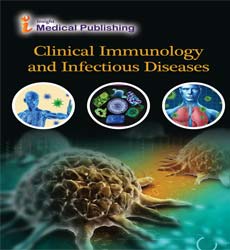Host–Pathogen Interactions in Viral Infections: Insights from Clinical Immunology
Nihan Ferda
Departments of Medicine and Immunology, University of Toronto, Toronto, ON M5S1A8, Canada
Corresponding author: Nihan Ferda Departments of Medicine and Immunology, University of Toronto, Toronto, ON M5S1A8, Canada, E-mail: nihan@ferda.ca
Received date: January 01, 2025, Manuscript No. Ipciid-25-20576; Editor assigned date: January 03, 2025, PreQC No. Ipciid-25-20576 (PQ); Reviewed date: January 15, 2025, QC No. Ipciid-25-20576; Revised date: January 22, 2025, Manuscript No. Ipciid-25-20576 (R); Published date: January 28, 2025, DOI: 10.36648/.9.1.1
Citation: Ferda N (2025) Hostâ??Pathogen Interactions in Viral Infections: Insights from Clinical Immunology. Clin Immunol Infect Dis Vol. 9 No.1:1
Introduction
Hostâ??pathogen interactions in viral infections represent a dynamic interplay between viral strategies to establish infection and host immune mechanisms designed to eliminate the pathogen. Clinical immunology provides critical insights into how innate and adaptive immunity shape viral pathogenesis, disease severity, and recovery, while also explaining why immune evasion, dysregulation, or overactivation can contribute to pathology. Understanding these interactions not only illuminates the mechanisms of viral diseases but also informs the development of vaccines, immunotherapies, and antiviral treatments [1].
Description
Innate immunity serves as the first line of defense in viral infections, where pattern recognition receptors such as Toll-like receptors (TLRs) and RIG-Iâ??like receptors detect viral nucleic acids and trigger the production of type I interferons and pro-inflammatory cytokines. These responses restrict viral replication and recruit immune effector cells, but clinical studies show that delays or deficiencies in interferon signaling, as observed in severe influenza or SARS-CoV-2 infection, are associated with higher viral loads and poor outcomes. Natural killer (NK) cells further contribute to early viral clearance by directly lysing infected cells [2]. Though some viruses, such as Cytomegalovirus (CMV), evolve mechanisms to evade NK recognition by downregulating or mimicking MHC molecules Adaptive immunity plays a central role in long-term control clearance of viral infections. CD8+ Cytotoxic T Lymphocytes (CTLs) recognize and destroy infected cells, while CD4+ helper T cells coordinate antibody production and memory formation. Clinical immunology highlights the importance of neutralizing antibodies in preventing reinfection, as demonstrated in vaccine success against hepatitis B and and measles [3]. However, viral mutations can alter antigenic epitopes, leading to immune escape, as seen with HIV and influenza. Persistent infections often result from viral strategies that impair T-cell responses, Persistent infections often result from viral strategies that impair T-cell responses including exhaustion mediated by checkpoint molecules such as PD-1, which has been observed in chronic hepatitis and HIV infections [4] Beyond protective responses, hostâ??pathogen interactions can also drive immunopathology. Overactive immune responses, such as cytokine storms in severe viral infections, cause widespread tissue damage and multi-organ failure. Molecular mimicry between viral and host proteins can trigger autoimmune reactions, as suggested in post-viral syndromes. Furthermore, clinical immunology studies reveal that host genetics, including HLA type and polymorphisms in immune genes, influence susceptibility, disease severity, and vaccine responsiveness. These insights guide precision medicine approaches that tailor immunotherapies and vaccination strategies to individual immune profiles, aiming to maximize protection while minimizing immunopathology [5].
Conclusion
In conclusion, hostâ??pathogen interactions in viral infections, as illuminated by clinical immunology, reveal a delicate balance between protective immunity and pathogenic immune responses. The effectiveness of innate and adaptive defenses, the viral capacity for immune evasion, and the hostâ??s genetic and immunological landscape collectively shape clinical outcomes. By deepening our understanding of these interactions, researchers and clinicians can design more effective vaccines, immunomodulatory therapies, and personalized interventions to improve control of viral diseases and mitigate their complications.
Acknowledgement
None.Conflict of Interest
None.References
- Casmil IC, Jin J, Won EJ, Huang C, Liao S, et al. (2025) The Advent of Clinical Self-Amplifying RNA Vaccines.Mol Ther 33: 2565–2582
Google Scholar Cross Ref Indexed at
- Sardesai NY, Weiner DB (2011) Electroporation Delivery of DNA Vaccines: Prospects for Success.Curr Opin Immunol 23: 421–429
Google Scholar Cross Ref Indexed at
- Shi S, Zhang L, Zheng A, Xie F, Kesse S, et al. (2024) Enhanced Anti-Tumor Efficacy of Electroporation (EP)-Mediated DNA Vaccine Boosted by Allogeneic Lymphocytes in Pre-Established Tumor Models. Cancer Immunol Immunother 73: 248
Google Scholar Cross Ref Indexed at
- Tonelli TP, Eickhoff JC, Johnson LE, Liu G, McNeel DG (2024) Long-Term Follow Up of Patients Treated with a DNA Vaccine (PTVG-Hp) for PSA-Recurrent Prostate Cancer.Hum Vaccines Immunother 20: 2395680
Google Scholar Cross Ref Indexed at
- Yadollahvandmiandoab R, Jalalizadeh M, Buosi K, Garcia-Perdomo HA, Reis LO (2022) Immunogenic Cell Death Role in Urothelial Cancer Therapy. Curr Oncol 29: 6700–6713
Google Scholar Cross Ref Indexed at
Open Access Journals
- Aquaculture & Veterinary Science
- Chemistry & Chemical Sciences
- Clinical Sciences
- Engineering
- General Science
- Genetics & Molecular Biology
- Health Care & Nursing
- Immunology & Microbiology
- Materials Science
- Mathematics & Physics
- Medical Sciences
- Neurology & Psychiatry
- Oncology & Cancer Science
- Pharmaceutical Sciences
